Report on Globalization's Impact on Sainsbury's Marketing Strategy
VerifiedAdded on 2023/06/09
|14
|4312
|469
Report
AI Summary
This report provides an in-depth analysis of the impact of globalization on J Sainsbury plc's marketing strategy. It uses marketing theories and frameworks, such as the marketing mix and the 7C's, to describe the role of marketing in creating value for customers. The report identifies the roles of stake...
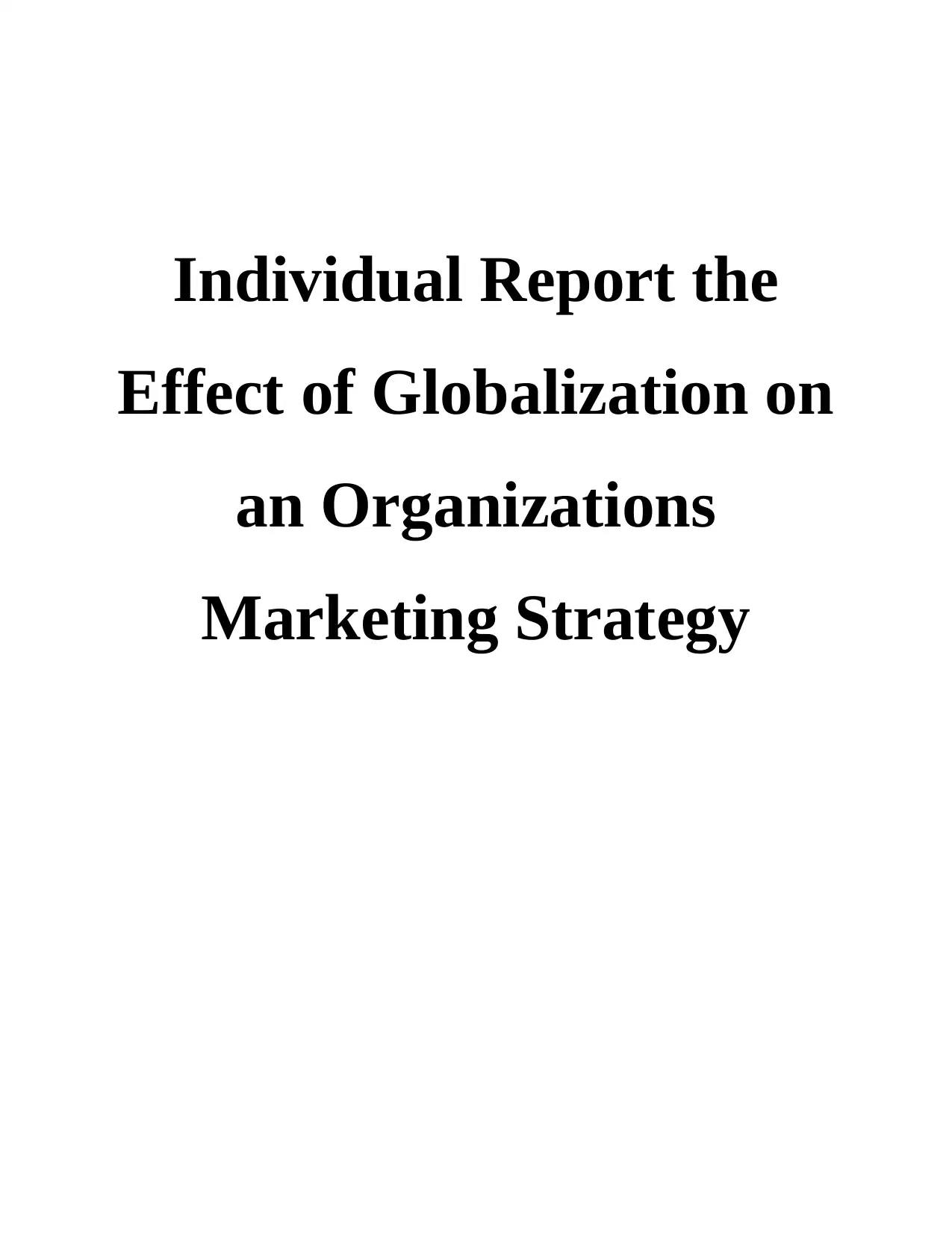
Individual Report the
Effect of Globalization on
an Organizations
Marketing Strategy
Effect of Globalization on
an Organizations
Marketing Strategy
Secure Best Marks with AI Grader
Need help grading? Try our AI Grader for instant feedback on your assignments.

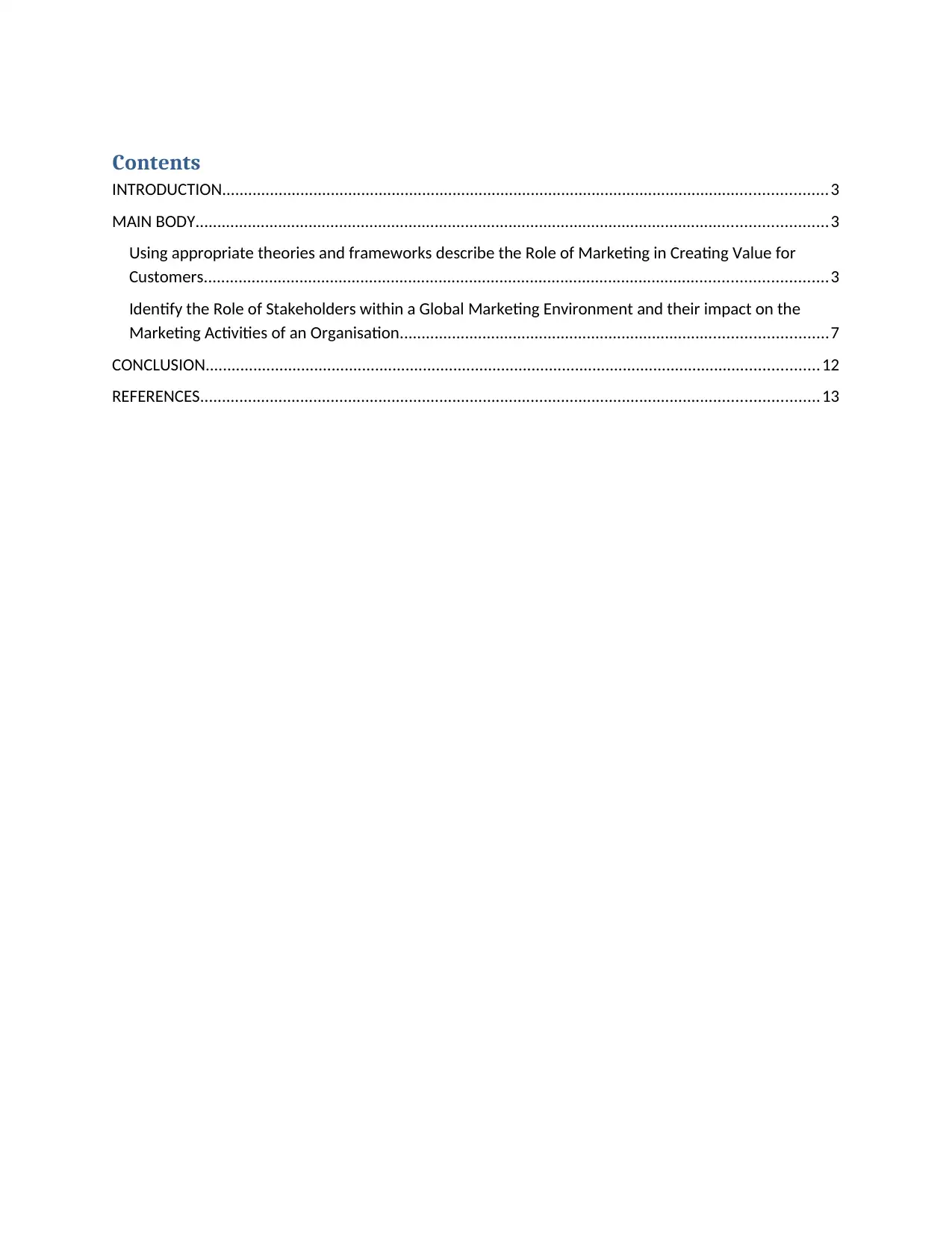
Contents
INTRODUCTION...........................................................................................................................................3
MAIN BODY.................................................................................................................................................3
Using appropriate theories and frameworks describe the Role of Marketing in Creating Value for
Customers...............................................................................................................................................3
Identify the Role of Stakeholders within a Global Marketing Environment and their impact on the
Marketing Activities of an Organisation..................................................................................................7
CONCLUSION.............................................................................................................................................12
REFERENCES..............................................................................................................................................13
INTRODUCTION...........................................................................................................................................3
MAIN BODY.................................................................................................................................................3
Using appropriate theories and frameworks describe the Role of Marketing in Creating Value for
Customers...............................................................................................................................................3
Identify the Role of Stakeholders within a Global Marketing Environment and their impact on the
Marketing Activities of an Organisation..................................................................................................7
CONCLUSION.............................................................................................................................................12
REFERENCES..............................................................................................................................................13
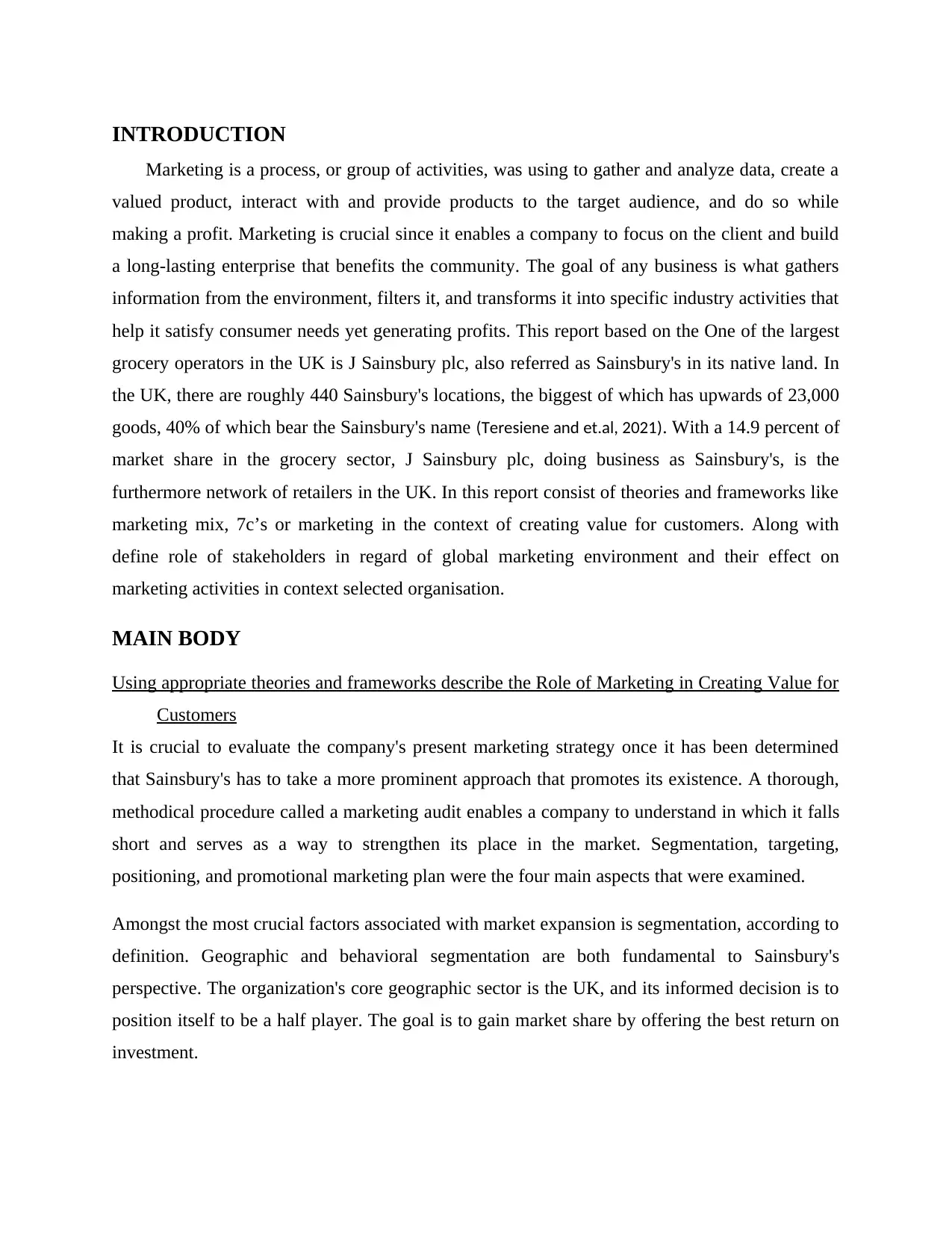
INTRODUCTION
Marketing is a process, or group of activities, was using to gather and analyze data, create a
valued product, interact with and provide products to the target audience, and do so while
making a profit. Marketing is crucial since it enables a company to focus on the client and build
a long-lasting enterprise that benefits the community. The goal of any business is what gathers
information from the environment, filters it, and transforms it into specific industry activities that
help it satisfy consumer needs yet generating profits. This report based on the One of the largest
grocery operators in the UK is J Sainsbury plc, also referred as Sainsbury's in its native land. In
the UK, there are roughly 440 Sainsbury's locations, the biggest of which has upwards of 23,000
goods, 40% of which bear the Sainsbury's name (Teresiene and et.al, 2021). With a 14.9 percent of
market share in the grocery sector, J Sainsbury plc, doing business as Sainsbury's, is the
furthermore network of retailers in the UK. In this report consist of theories and frameworks like
marketing mix, 7c’s or marketing in the context of creating value for customers. Along with
define role of stakeholders in regard of global marketing environment and their effect on
marketing activities in context selected organisation.
MAIN BODY
Using appropriate theories and frameworks describe the Role of Marketing in Creating Value for
Customers
It is crucial to evaluate the company's present marketing strategy once it has been determined
that Sainsbury's has to take a more prominent approach that promotes its existence. A thorough,
methodical procedure called a marketing audit enables a company to understand in which it falls
short and serves as a way to strengthen its place in the market. Segmentation, targeting,
positioning, and promotional marketing plan were the four main aspects that were examined.
Amongst the most crucial factors associated with market expansion is segmentation, according to
definition. Geographic and behavioral segmentation are both fundamental to Sainsbury's
perspective. The organization's core geographic sector is the UK, and its informed decision is to
position itself to be a half player. The goal is to gain market share by offering the best return on
investment.
Marketing is a process, or group of activities, was using to gather and analyze data, create a
valued product, interact with and provide products to the target audience, and do so while
making a profit. Marketing is crucial since it enables a company to focus on the client and build
a long-lasting enterprise that benefits the community. The goal of any business is what gathers
information from the environment, filters it, and transforms it into specific industry activities that
help it satisfy consumer needs yet generating profits. This report based on the One of the largest
grocery operators in the UK is J Sainsbury plc, also referred as Sainsbury's in its native land. In
the UK, there are roughly 440 Sainsbury's locations, the biggest of which has upwards of 23,000
goods, 40% of which bear the Sainsbury's name (Teresiene and et.al, 2021). With a 14.9 percent of
market share in the grocery sector, J Sainsbury plc, doing business as Sainsbury's, is the
furthermore network of retailers in the UK. In this report consist of theories and frameworks like
marketing mix, 7c’s or marketing in the context of creating value for customers. Along with
define role of stakeholders in regard of global marketing environment and their effect on
marketing activities in context selected organisation.
MAIN BODY
Using appropriate theories and frameworks describe the Role of Marketing in Creating Value for
Customers
It is crucial to evaluate the company's present marketing strategy once it has been determined
that Sainsbury's has to take a more prominent approach that promotes its existence. A thorough,
methodical procedure called a marketing audit enables a company to understand in which it falls
short and serves as a way to strengthen its place in the market. Segmentation, targeting,
positioning, and promotional marketing plan were the four main aspects that were examined.
Amongst the most crucial factors associated with market expansion is segmentation, according to
definition. Geographic and behavioral segmentation are both fundamental to Sainsbury's
perspective. The organization's core geographic sector is the UK, and its informed decision is to
position itself to be a half player. The goal is to gain market share by offering the best return on
investment.
Secure Best Marks with AI Grader
Need help grading? Try our AI Grader for instant feedback on your assignments.
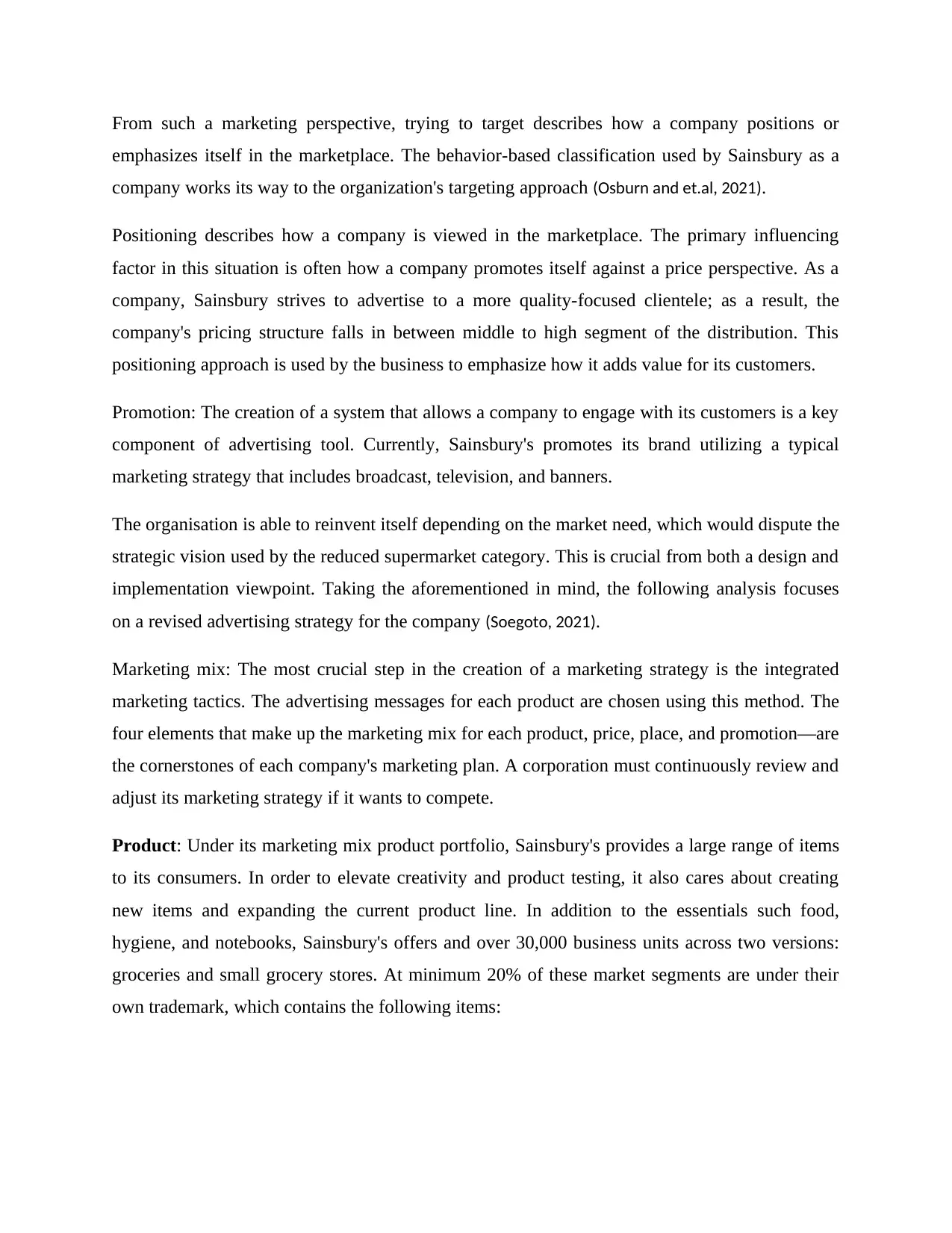
From such a marketing perspective, trying to target describes how a company positions or
emphasizes itself in the marketplace. The behavior-based classification used by Sainsbury as a
company works its way to the organization's targeting approach (Osburn and et.al, 2021).
Positioning describes how a company is viewed in the marketplace. The primary influencing
factor in this situation is often how a company promotes itself against a price perspective. As a
company, Sainsbury strives to advertise to a more quality-focused clientele; as a result, the
company's pricing structure falls in between middle to high segment of the distribution. This
positioning approach is used by the business to emphasize how it adds value for its customers.
Promotion: The creation of a system that allows a company to engage with its customers is a key
component of advertising tool. Currently, Sainsbury's promotes its brand utilizing a typical
marketing strategy that includes broadcast, television, and banners.
The organisation is able to reinvent itself depending on the market need, which would dispute the
strategic vision used by the reduced supermarket category. This is crucial from both a design and
implementation viewpoint. Taking the aforementioned in mind, the following analysis focuses
on a revised advertising strategy for the company (Soegoto, 2021).
Marketing mix: The most crucial step in the creation of a marketing strategy is the integrated
marketing tactics. The advertising messages for each product are chosen using this method. The
four elements that make up the marketing mix for each product, price, place, and promotion—are
the cornerstones of each company's marketing plan. A corporation must continuously review and
adjust its marketing strategy if it wants to compete.
Product: Under its marketing mix product portfolio, Sainsbury's provides a large range of items
to its consumers. In order to elevate creativity and product testing, it also cares about creating
new items and expanding the current product line. In addition to the essentials such food,
hygiene, and notebooks, Sainsbury's offers and over 30,000 business units across two versions:
groceries and small grocery stores. At minimum 20% of these market segments are under their
own trademark, which contains the following items:
emphasizes itself in the marketplace. The behavior-based classification used by Sainsbury as a
company works its way to the organization's targeting approach (Osburn and et.al, 2021).
Positioning describes how a company is viewed in the marketplace. The primary influencing
factor in this situation is often how a company promotes itself against a price perspective. As a
company, Sainsbury strives to advertise to a more quality-focused clientele; as a result, the
company's pricing structure falls in between middle to high segment of the distribution. This
positioning approach is used by the business to emphasize how it adds value for its customers.
Promotion: The creation of a system that allows a company to engage with its customers is a key
component of advertising tool. Currently, Sainsbury's promotes its brand utilizing a typical
marketing strategy that includes broadcast, television, and banners.
The organisation is able to reinvent itself depending on the market need, which would dispute the
strategic vision used by the reduced supermarket category. This is crucial from both a design and
implementation viewpoint. Taking the aforementioned in mind, the following analysis focuses
on a revised advertising strategy for the company (Soegoto, 2021).
Marketing mix: The most crucial step in the creation of a marketing strategy is the integrated
marketing tactics. The advertising messages for each product are chosen using this method. The
four elements that make up the marketing mix for each product, price, place, and promotion—are
the cornerstones of each company's marketing plan. A corporation must continuously review and
adjust its marketing strategy if it wants to compete.
Product: Under its marketing mix product portfolio, Sainsbury's provides a large range of items
to its consumers. In order to elevate creativity and product testing, it also cares about creating
new items and expanding the current product line. In addition to the essentials such food,
hygiene, and notebooks, Sainsbury's offers and over 30,000 business units across two versions:
groceries and small grocery stores. At minimum 20% of these market segments are under their
own trademark, which contains the following items:
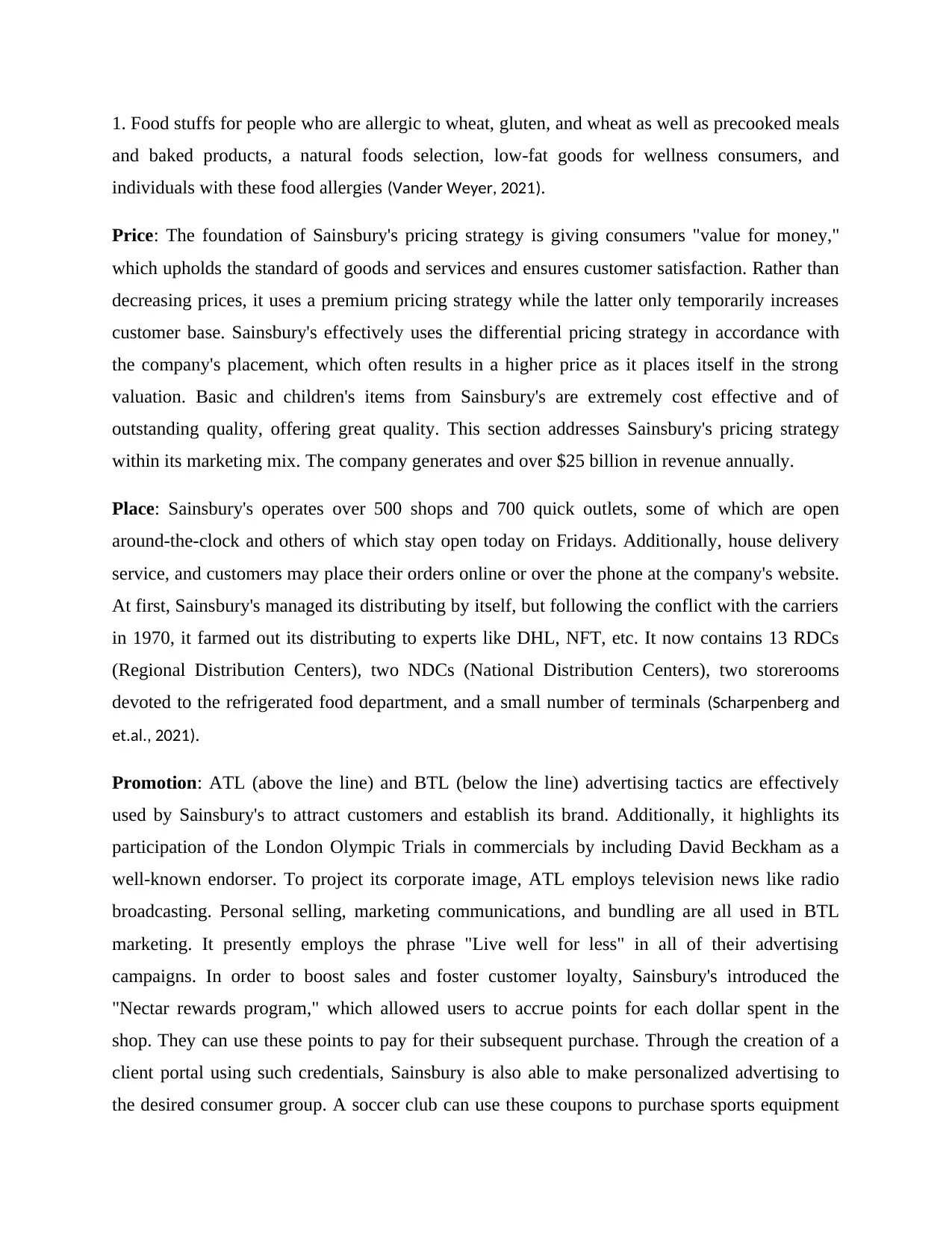
1. Food stuffs for people who are allergic to wheat, gluten, and wheat as well as precooked meals
and baked products, a natural foods selection, low-fat goods for wellness consumers, and
individuals with these food allergies (Vander Weyer, 2021).
Price: The foundation of Sainsbury's pricing strategy is giving consumers "value for money,"
which upholds the standard of goods and services and ensures customer satisfaction. Rather than
decreasing prices, it uses a premium pricing strategy while the latter only temporarily increases
customer base. Sainsbury's effectively uses the differential pricing strategy in accordance with
the company's placement, which often results in a higher price as it places itself in the strong
valuation. Basic and children's items from Sainsbury's are extremely cost effective and of
outstanding quality, offering great quality. This section addresses Sainsbury's pricing strategy
within its marketing mix. The company generates and over $25 billion in revenue annually.
Place: Sainsbury's operates over 500 shops and 700 quick outlets, some of which are open
around-the-clock and others of which stay open today on Fridays. Additionally, house delivery
service, and customers may place their orders online or over the phone at the company's website.
At first, Sainsbury's managed its distributing by itself, but following the conflict with the carriers
in 1970, it farmed out its distributing to experts like DHL, NFT, etc. It now contains 13 RDCs
(Regional Distribution Centers), two NDCs (National Distribution Centers), two storerooms
devoted to the refrigerated food department, and a small number of terminals (Scharpenberg and
et.al., 2021).
Promotion: ATL (above the line) and BTL (below the line) advertising tactics are effectively
used by Sainsbury's to attract customers and establish its brand. Additionally, it highlights its
participation of the London Olympic Trials in commercials by including David Beckham as a
well-known endorser. To project its corporate image, ATL employs television news like radio
broadcasting. Personal selling, marketing communications, and bundling are all used in BTL
marketing. It presently employs the phrase "Live well for less" in all of their advertising
campaigns. In order to boost sales and foster customer loyalty, Sainsbury's introduced the
"Nectar rewards program," which allowed users to accrue points for each dollar spent in the
shop. They can use these points to pay for their subsequent purchase. Through the creation of a
client portal using such credentials, Sainsbury is also able to make personalized advertising to
the desired consumer group. A soccer club can use these coupons to purchase sports equipment
and baked products, a natural foods selection, low-fat goods for wellness consumers, and
individuals with these food allergies (Vander Weyer, 2021).
Price: The foundation of Sainsbury's pricing strategy is giving consumers "value for money,"
which upholds the standard of goods and services and ensures customer satisfaction. Rather than
decreasing prices, it uses a premium pricing strategy while the latter only temporarily increases
customer base. Sainsbury's effectively uses the differential pricing strategy in accordance with
the company's placement, which often results in a higher price as it places itself in the strong
valuation. Basic and children's items from Sainsbury's are extremely cost effective and of
outstanding quality, offering great quality. This section addresses Sainsbury's pricing strategy
within its marketing mix. The company generates and over $25 billion in revenue annually.
Place: Sainsbury's operates over 500 shops and 700 quick outlets, some of which are open
around-the-clock and others of which stay open today on Fridays. Additionally, house delivery
service, and customers may place their orders online or over the phone at the company's website.
At first, Sainsbury's managed its distributing by itself, but following the conflict with the carriers
in 1970, it farmed out its distributing to experts like DHL, NFT, etc. It now contains 13 RDCs
(Regional Distribution Centers), two NDCs (National Distribution Centers), two storerooms
devoted to the refrigerated food department, and a small number of terminals (Scharpenberg and
et.al., 2021).
Promotion: ATL (above the line) and BTL (below the line) advertising tactics are effectively
used by Sainsbury's to attract customers and establish its brand. Additionally, it highlights its
participation of the London Olympic Trials in commercials by including David Beckham as a
well-known endorser. To project its corporate image, ATL employs television news like radio
broadcasting. Personal selling, marketing communications, and bundling are all used in BTL
marketing. It presently employs the phrase "Live well for less" in all of their advertising
campaigns. In order to boost sales and foster customer loyalty, Sainsbury's introduced the
"Nectar rewards program," which allowed users to accrue points for each dollar spent in the
shop. They can use these points to pay for their subsequent purchase. Through the creation of a
client portal using such credentials, Sainsbury is also able to make personalized advertising to
the desired consumer group. A soccer club can use these coupons to purchase sports equipment
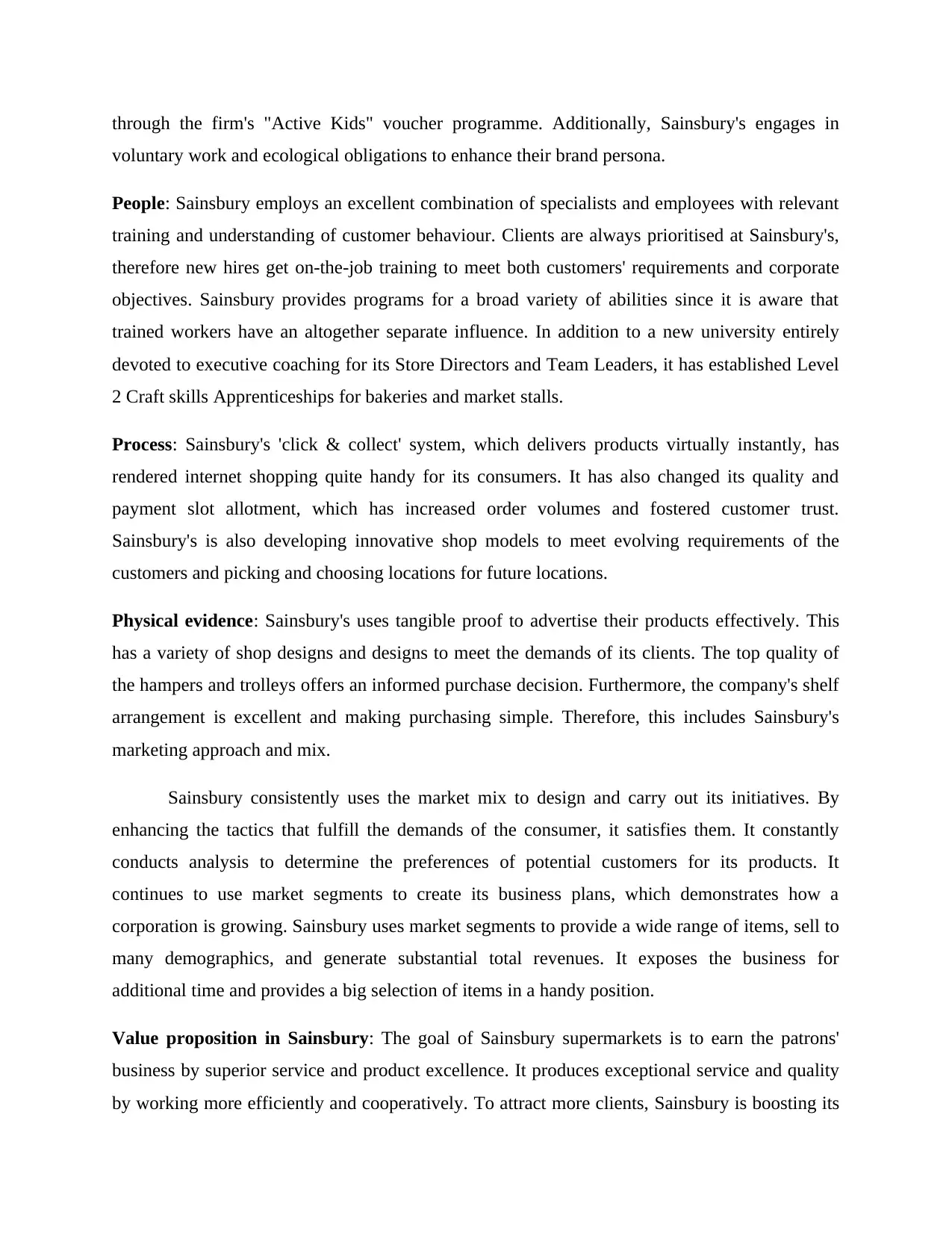
through the firm's "Active Kids" voucher programme. Additionally, Sainsbury's engages in
voluntary work and ecological obligations to enhance their brand persona.
People: Sainsbury employs an excellent combination of specialists and employees with relevant
training and understanding of customer behaviour. Clients are always prioritised at Sainsbury's,
therefore new hires get on-the-job training to meet both customers' requirements and corporate
objectives. Sainsbury provides programs for a broad variety of abilities since it is aware that
trained workers have an altogether separate influence. In addition to a new university entirely
devoted to executive coaching for its Store Directors and Team Leaders, it has established Level
2 Craft skills Apprenticeships for bakeries and market stalls.
Process: Sainsbury's 'click & collect' system, which delivers products virtually instantly, has
rendered internet shopping quite handy for its consumers. It has also changed its quality and
payment slot allotment, which has increased order volumes and fostered customer trust.
Sainsbury's is also developing innovative shop models to meet evolving requirements of the
customers and picking and choosing locations for future locations.
Physical evidence: Sainsbury's uses tangible proof to advertise their products effectively. This
has a variety of shop designs and designs to meet the demands of its clients. The top quality of
the hampers and trolleys offers an informed purchase decision. Furthermore, the company's shelf
arrangement is excellent and making purchasing simple. Therefore, this includes Sainsbury's
marketing approach and mix.
Sainsbury consistently uses the market mix to design and carry out its initiatives. By
enhancing the tactics that fulfill the demands of the consumer, it satisfies them. It constantly
conducts analysis to determine the preferences of potential customers for its products. It
continues to use market segments to create its business plans, which demonstrates how a
corporation is growing. Sainsbury uses market segments to provide a wide range of items, sell to
many demographics, and generate substantial total revenues. It exposes the business for
additional time and provides a big selection of items in a handy position.
Value proposition in Sainsbury: The goal of Sainsbury supermarkets is to earn the patrons'
business by superior service and product excellence. It produces exceptional service and quality
by working more efficiently and cooperatively. To attract more clients, Sainsbury is boosting its
voluntary work and ecological obligations to enhance their brand persona.
People: Sainsbury employs an excellent combination of specialists and employees with relevant
training and understanding of customer behaviour. Clients are always prioritised at Sainsbury's,
therefore new hires get on-the-job training to meet both customers' requirements and corporate
objectives. Sainsbury provides programs for a broad variety of abilities since it is aware that
trained workers have an altogether separate influence. In addition to a new university entirely
devoted to executive coaching for its Store Directors and Team Leaders, it has established Level
2 Craft skills Apprenticeships for bakeries and market stalls.
Process: Sainsbury's 'click & collect' system, which delivers products virtually instantly, has
rendered internet shopping quite handy for its consumers. It has also changed its quality and
payment slot allotment, which has increased order volumes and fostered customer trust.
Sainsbury's is also developing innovative shop models to meet evolving requirements of the
customers and picking and choosing locations for future locations.
Physical evidence: Sainsbury's uses tangible proof to advertise their products effectively. This
has a variety of shop designs and designs to meet the demands of its clients. The top quality of
the hampers and trolleys offers an informed purchase decision. Furthermore, the company's shelf
arrangement is excellent and making purchasing simple. Therefore, this includes Sainsbury's
marketing approach and mix.
Sainsbury consistently uses the market mix to design and carry out its initiatives. By
enhancing the tactics that fulfill the demands of the consumer, it satisfies them. It constantly
conducts analysis to determine the preferences of potential customers for its products. It
continues to use market segments to create its business plans, which demonstrates how a
corporation is growing. Sainsbury uses market segments to provide a wide range of items, sell to
many demographics, and generate substantial total revenues. It exposes the business for
additional time and provides a big selection of items in a handy position.
Value proposition in Sainsbury: The goal of Sainsbury supermarkets is to earn the patrons'
business by superior service and product excellence. It produces exceptional service and quality
by working more efficiently and cooperatively. To attract more clients, Sainsbury is boosting its
Paraphrase This Document
Need a fresh take? Get an instant paraphrase of this document with our AI Paraphraser
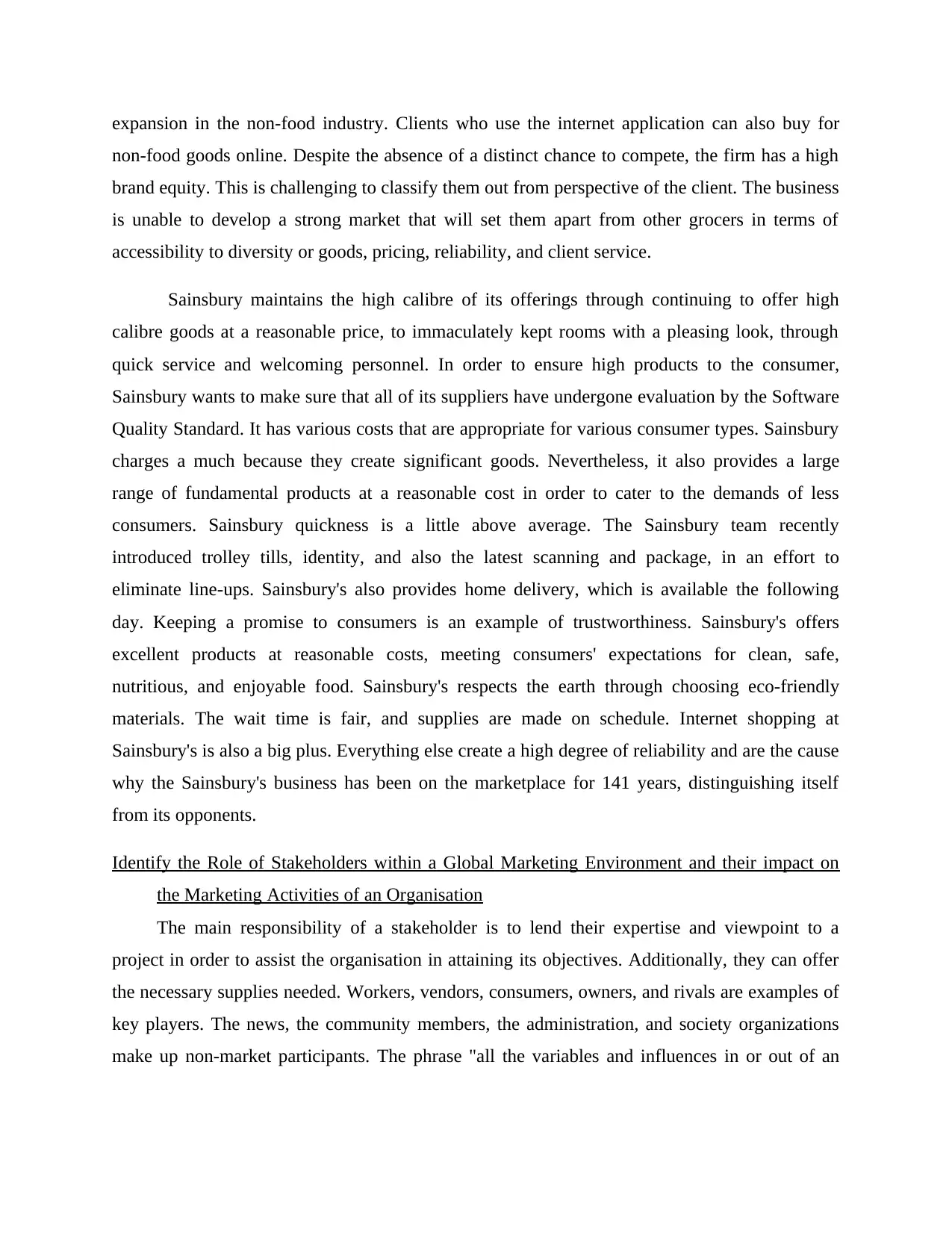
expansion in the non-food industry. Clients who use the internet application can also buy for
non-food goods online. Despite the absence of a distinct chance to compete, the firm has a high
brand equity. This is challenging to classify them out from perspective of the client. The business
is unable to develop a strong market that will set them apart from other grocers in terms of
accessibility to diversity or goods, pricing, reliability, and client service.
Sainsbury maintains the high calibre of its offerings through continuing to offer high
calibre goods at a reasonable price, to immaculately kept rooms with a pleasing look, through
quick service and welcoming personnel. In order to ensure high products to the consumer,
Sainsbury wants to make sure that all of its suppliers have undergone evaluation by the Software
Quality Standard. It has various costs that are appropriate for various consumer types. Sainsbury
charges a much because they create significant goods. Nevertheless, it also provides a large
range of fundamental products at a reasonable cost in order to cater to the demands of less
consumers. Sainsbury quickness is a little above average. The Sainsbury team recently
introduced trolley tills, identity, and also the latest scanning and package, in an effort to
eliminate line-ups. Sainsbury's also provides home delivery, which is available the following
day. Keeping a promise to consumers is an example of trustworthiness. Sainsbury's offers
excellent products at reasonable costs, meeting consumers' expectations for clean, safe,
nutritious, and enjoyable food. Sainsbury's respects the earth through choosing eco-friendly
materials. The wait time is fair, and supplies are made on schedule. Internet shopping at
Sainsbury's is also a big plus. Everything else create a high degree of reliability and are the cause
why the Sainsbury's business has been on the marketplace for 141 years, distinguishing itself
from its opponents.
Identify the Role of Stakeholders within a Global Marketing Environment and their impact on
the Marketing Activities of an Organisation
The main responsibility of a stakeholder is to lend their expertise and viewpoint to a
project in order to assist the organisation in attaining its objectives. Additionally, they can offer
the necessary supplies needed. Workers, vendors, consumers, owners, and rivals are examples of
key players. The news, the community members, the administration, and society organizations
make up non-market participants. The phrase "all the variables and influences in or out of an
non-food goods online. Despite the absence of a distinct chance to compete, the firm has a high
brand equity. This is challenging to classify them out from perspective of the client. The business
is unable to develop a strong market that will set them apart from other grocers in terms of
accessibility to diversity or goods, pricing, reliability, and client service.
Sainsbury maintains the high calibre of its offerings through continuing to offer high
calibre goods at a reasonable price, to immaculately kept rooms with a pleasing look, through
quick service and welcoming personnel. In order to ensure high products to the consumer,
Sainsbury wants to make sure that all of its suppliers have undergone evaluation by the Software
Quality Standard. It has various costs that are appropriate for various consumer types. Sainsbury
charges a much because they create significant goods. Nevertheless, it also provides a large
range of fundamental products at a reasonable cost in order to cater to the demands of less
consumers. Sainsbury quickness is a little above average. The Sainsbury team recently
introduced trolley tills, identity, and also the latest scanning and package, in an effort to
eliminate line-ups. Sainsbury's also provides home delivery, which is available the following
day. Keeping a promise to consumers is an example of trustworthiness. Sainsbury's offers
excellent products at reasonable costs, meeting consumers' expectations for clean, safe,
nutritious, and enjoyable food. Sainsbury's respects the earth through choosing eco-friendly
materials. The wait time is fair, and supplies are made on schedule. Internet shopping at
Sainsbury's is also a big plus. Everything else create a high degree of reliability and are the cause
why the Sainsbury's business has been on the marketplace for 141 years, distinguishing itself
from its opponents.
Identify the Role of Stakeholders within a Global Marketing Environment and their impact on
the Marketing Activities of an Organisation
The main responsibility of a stakeholder is to lend their expertise and viewpoint to a
project in order to assist the organisation in attaining its objectives. Additionally, they can offer
the necessary supplies needed. Workers, vendors, consumers, owners, and rivals are examples of
key players. The news, the community members, the administration, and society organizations
make up non-market participants. The phrase "all the variables and influences in or out of an
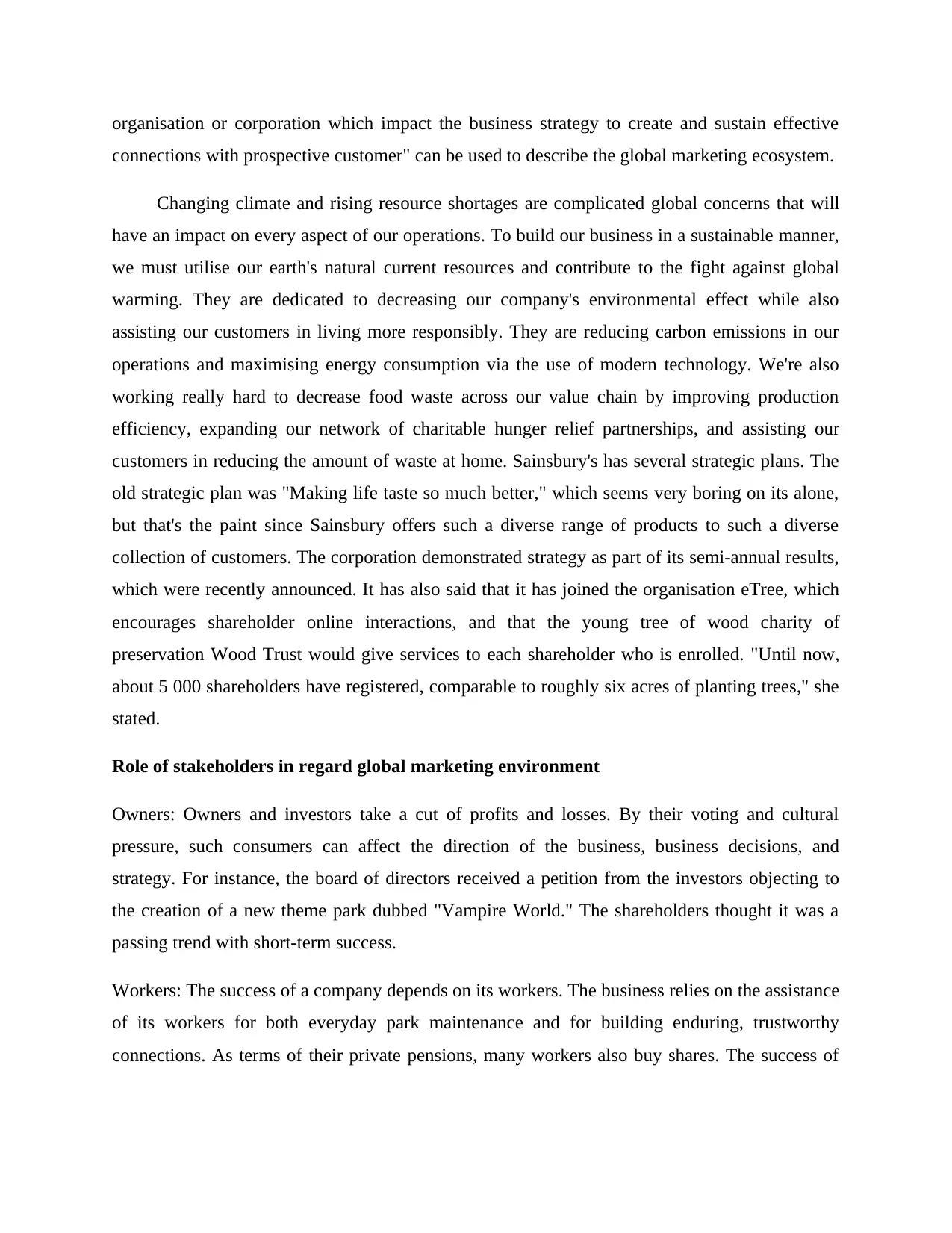
organisation or corporation which impact the business strategy to create and sustain effective
connections with prospective customer" can be used to describe the global marketing ecosystem.
Changing climate and rising resource shortages are complicated global concerns that will
have an impact on every aspect of our operations. To build our business in a sustainable manner,
we must utilise our earth's natural current resources and contribute to the fight against global
warming. They are dedicated to decreasing our company's environmental effect while also
assisting our customers in living more responsibly. They are reducing carbon emissions in our
operations and maximising energy consumption via the use of modern technology. We're also
working really hard to decrease food waste across our value chain by improving production
efficiency, expanding our network of charitable hunger relief partnerships, and assisting our
customers in reducing the amount of waste at home. Sainsbury's has several strategic plans. The
old strategic plan was "Making life taste so much better," which seems very boring on its alone,
but that's the paint since Sainsbury offers such a diverse range of products to such a diverse
collection of customers. The corporation demonstrated strategy as part of its semi-annual results,
which were recently announced. It has also said that it has joined the organisation eTree, which
encourages shareholder online interactions, and that the young tree of wood charity of
preservation Wood Trust would give services to each shareholder who is enrolled. "Until now,
about 5 000 shareholders have registered, comparable to roughly six acres of planting trees," she
stated.
Role of stakeholders in regard global marketing environment
Owners: Owners and investors take a cut of profits and losses. By their voting and cultural
pressure, such consumers can affect the direction of the business, business decisions, and
strategy. For instance, the board of directors received a petition from the investors objecting to
the creation of a new theme park dubbed "Vampire World." The shareholders thought it was a
passing trend with short-term success.
Workers: The success of a company depends on its workers. The business relies on the assistance
of its workers for both everyday park maintenance and for building enduring, trustworthy
connections. As terms of their private pensions, many workers also buy shares. The success of
connections with prospective customer" can be used to describe the global marketing ecosystem.
Changing climate and rising resource shortages are complicated global concerns that will
have an impact on every aspect of our operations. To build our business in a sustainable manner,
we must utilise our earth's natural current resources and contribute to the fight against global
warming. They are dedicated to decreasing our company's environmental effect while also
assisting our customers in living more responsibly. They are reducing carbon emissions in our
operations and maximising energy consumption via the use of modern technology. We're also
working really hard to decrease food waste across our value chain by improving production
efficiency, expanding our network of charitable hunger relief partnerships, and assisting our
customers in reducing the amount of waste at home. Sainsbury's has several strategic plans. The
old strategic plan was "Making life taste so much better," which seems very boring on its alone,
but that's the paint since Sainsbury offers such a diverse range of products to such a diverse
collection of customers. The corporation demonstrated strategy as part of its semi-annual results,
which were recently announced. It has also said that it has joined the organisation eTree, which
encourages shareholder online interactions, and that the young tree of wood charity of
preservation Wood Trust would give services to each shareholder who is enrolled. "Until now,
about 5 000 shareholders have registered, comparable to roughly six acres of planting trees," she
stated.
Role of stakeholders in regard global marketing environment
Owners: Owners and investors take a cut of profits and losses. By their voting and cultural
pressure, such consumers can affect the direction of the business, business decisions, and
strategy. For instance, the board of directors received a petition from the investors objecting to
the creation of a new theme park dubbed "Vampire World." The shareholders thought it was a
passing trend with short-term success.
Workers: The success of a company depends on its workers. The business relies on the assistance
of its workers for both everyday park maintenance and for building enduring, trustworthy
connections. As terms of their private pensions, many workers also buy shares. The success of
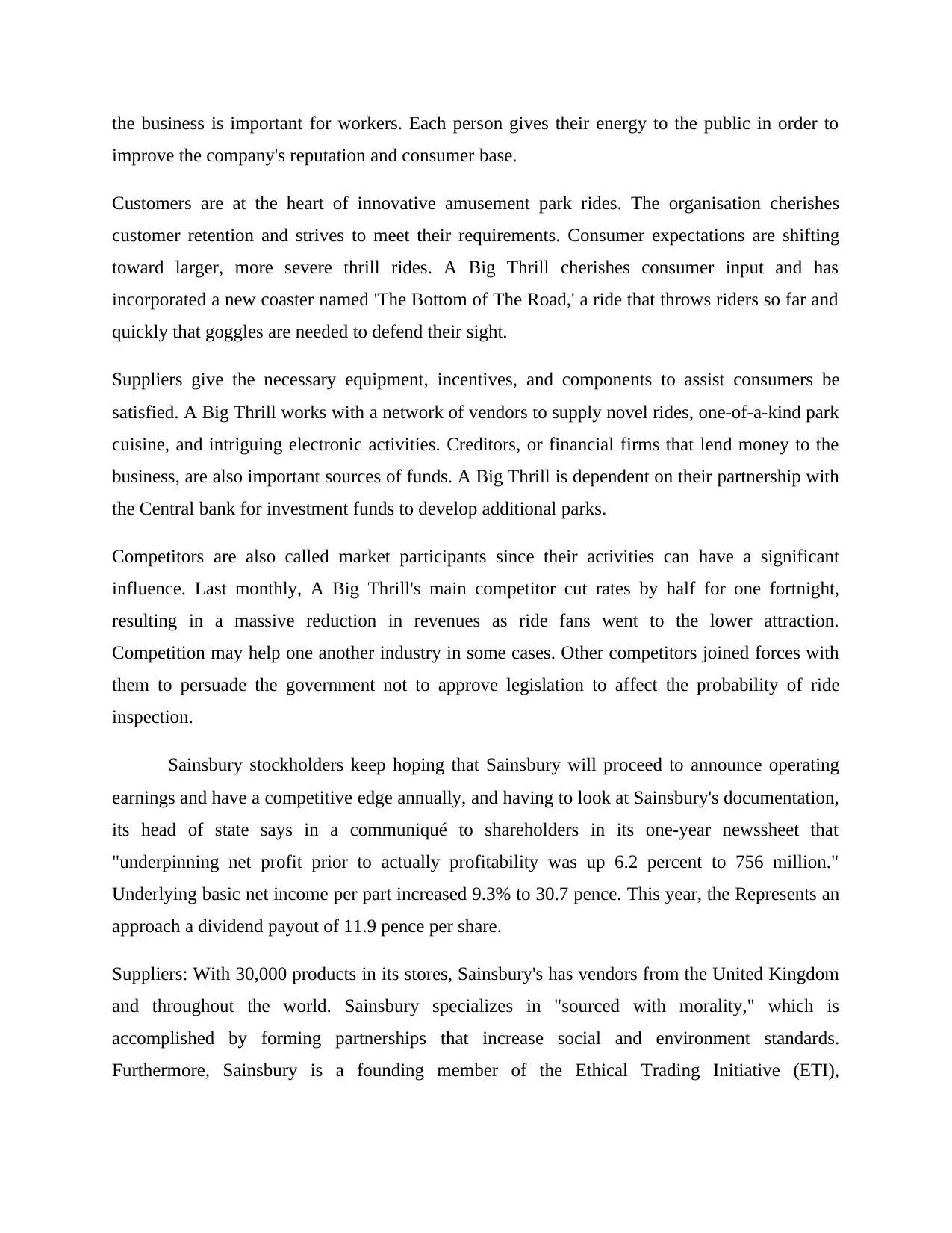
the business is important for workers. Each person gives their energy to the public in order to
improve the company's reputation and consumer base.
Customers are at the heart of innovative amusement park rides. The organisation cherishes
customer retention and strives to meet their requirements. Consumer expectations are shifting
toward larger, more severe thrill rides. A Big Thrill cherishes consumer input and has
incorporated a new coaster named 'The Bottom of The Road,' a ride that throws riders so far and
quickly that goggles are needed to defend their sight.
Suppliers give the necessary equipment, incentives, and components to assist consumers be
satisfied. A Big Thrill works with a network of vendors to supply novel rides, one-of-a-kind park
cuisine, and intriguing electronic activities. Creditors, or financial firms that lend money to the
business, are also important sources of funds. A Big Thrill is dependent on their partnership with
the Central bank for investment funds to develop additional parks.
Competitors are also called market participants since their activities can have a significant
influence. Last monthly, A Big Thrill's main competitor cut rates by half for one fortnight,
resulting in a massive reduction in revenues as ride fans went to the lower attraction.
Competition may help one another industry in some cases. Other competitors joined forces with
them to persuade the government not to approve legislation to affect the probability of ride
inspection.
Sainsbury stockholders keep hoping that Sainsbury will proceed to announce operating
earnings and have a competitive edge annually, and having to look at Sainsbury's documentation,
its head of state says in a communiqué to shareholders in its one-year newssheet that
"underpinning net profit prior to actually profitability was up 6.2 percent to 756 million."
Underlying basic net income per part increased 9.3% to 30.7 pence. This year, the Represents an
approach a dividend payout of 11.9 pence per share.
Suppliers: With 30,000 products in its stores, Sainsbury's has vendors from the United Kingdom
and throughout the world. Sainsbury specializes in "sourced with morality," which is
accomplished by forming partnerships that increase social and environment standards.
Furthermore, Sainsbury is a founding member of the Ethical Trading Initiative (ETI),
improve the company's reputation and consumer base.
Customers are at the heart of innovative amusement park rides. The organisation cherishes
customer retention and strives to meet their requirements. Consumer expectations are shifting
toward larger, more severe thrill rides. A Big Thrill cherishes consumer input and has
incorporated a new coaster named 'The Bottom of The Road,' a ride that throws riders so far and
quickly that goggles are needed to defend their sight.
Suppliers give the necessary equipment, incentives, and components to assist consumers be
satisfied. A Big Thrill works with a network of vendors to supply novel rides, one-of-a-kind park
cuisine, and intriguing electronic activities. Creditors, or financial firms that lend money to the
business, are also important sources of funds. A Big Thrill is dependent on their partnership with
the Central bank for investment funds to develop additional parks.
Competitors are also called market participants since their activities can have a significant
influence. Last monthly, A Big Thrill's main competitor cut rates by half for one fortnight,
resulting in a massive reduction in revenues as ride fans went to the lower attraction.
Competition may help one another industry in some cases. Other competitors joined forces with
them to persuade the government not to approve legislation to affect the probability of ride
inspection.
Sainsbury stockholders keep hoping that Sainsbury will proceed to announce operating
earnings and have a competitive edge annually, and having to look at Sainsbury's documentation,
its head of state says in a communiqué to shareholders in its one-year newssheet that
"underpinning net profit prior to actually profitability was up 6.2 percent to 756 million."
Underlying basic net income per part increased 9.3% to 30.7 pence. This year, the Represents an
approach a dividend payout of 11.9 pence per share.
Suppliers: With 30,000 products in its stores, Sainsbury's has vendors from the United Kingdom
and throughout the world. Sainsbury specializes in "sourced with morality," which is
accomplished by forming partnerships that increase social and environment standards.
Furthermore, Sainsbury is a founding member of the Ethical Trading Initiative (ETI),
Secure Best Marks with AI Grader
Need help grading? Try our AI Grader for instant feedback on your assignments.
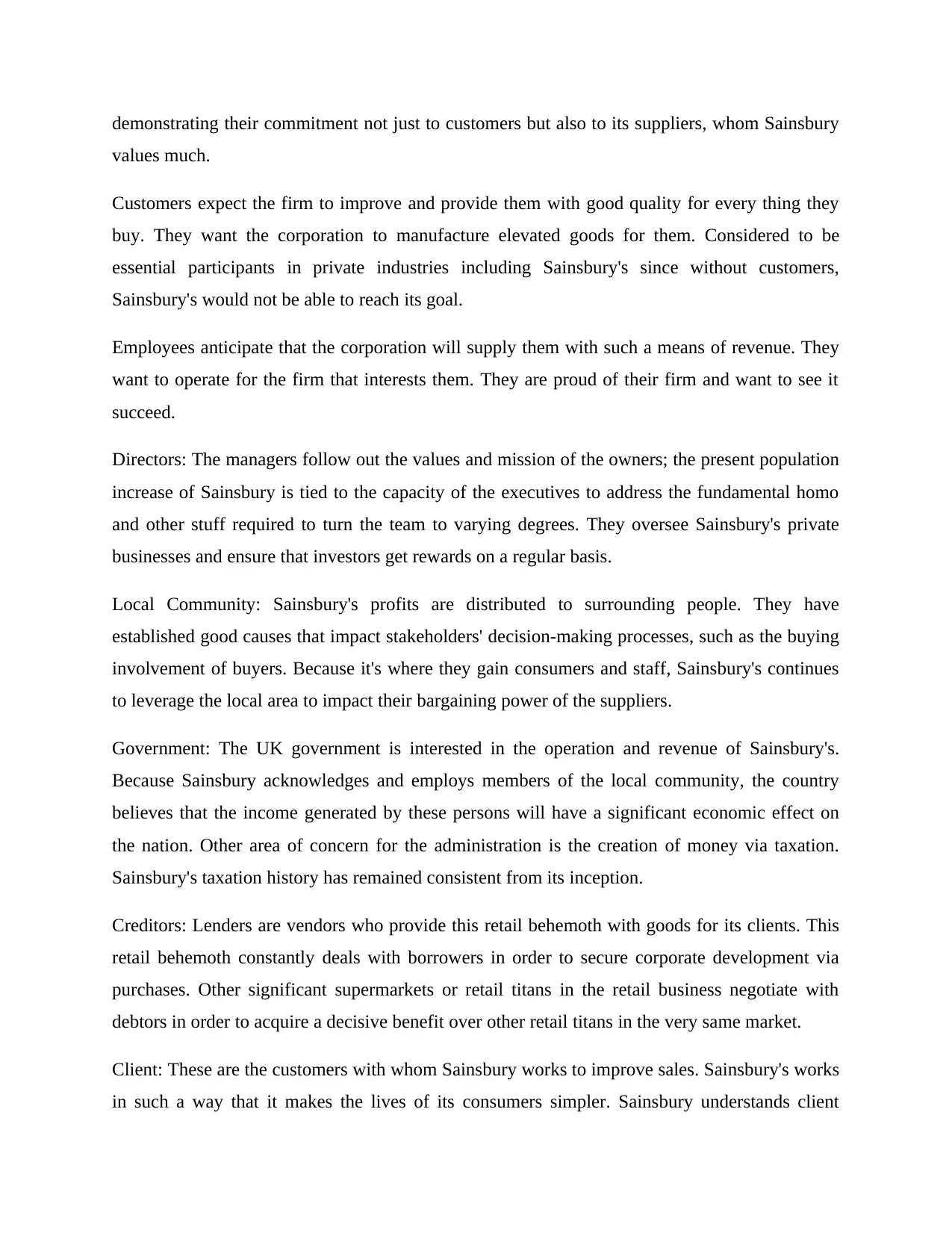
demonstrating their commitment not just to customers but also to its suppliers, whom Sainsbury
values much.
Customers expect the firm to improve and provide them with good quality for every thing they
buy. They want the corporation to manufacture elevated goods for them. Considered to be
essential participants in private industries including Sainsbury's since without customers,
Sainsbury's would not be able to reach its goal.
Employees anticipate that the corporation will supply them with such a means of revenue. They
want to operate for the firm that interests them. They are proud of their firm and want to see it
succeed.
Directors: The managers follow out the values and mission of the owners; the present population
increase of Sainsbury is tied to the capacity of the executives to address the fundamental homo
and other stuff required to turn the team to varying degrees. They oversee Sainsbury's private
businesses and ensure that investors get rewards on a regular basis.
Local Community: Sainsbury's profits are distributed to surrounding people. They have
established good causes that impact stakeholders' decision-making processes, such as the buying
involvement of buyers. Because it's where they gain consumers and staff, Sainsbury's continues
to leverage the local area to impact their bargaining power of the suppliers.
Government: The UK government is interested in the operation and revenue of Sainsbury's.
Because Sainsbury acknowledges and employs members of the local community, the country
believes that the income generated by these persons will have a significant economic effect on
the nation. Other area of concern for the administration is the creation of money via taxation.
Sainsbury's taxation history has remained consistent from its inception.
Creditors: Lenders are vendors who provide this retail behemoth with goods for its clients. This
retail behemoth constantly deals with borrowers in order to secure corporate development via
purchases. Other significant supermarkets or retail titans in the retail business negotiate with
debtors in order to acquire a decisive benefit over other retail titans in the very same market.
Client: These are the customers with whom Sainsbury works to improve sales. Sainsbury's works
in such a way that it makes the lives of its consumers simpler. Sainsbury understands client
values much.
Customers expect the firm to improve and provide them with good quality for every thing they
buy. They want the corporation to manufacture elevated goods for them. Considered to be
essential participants in private industries including Sainsbury's since without customers,
Sainsbury's would not be able to reach its goal.
Employees anticipate that the corporation will supply them with such a means of revenue. They
want to operate for the firm that interests them. They are proud of their firm and want to see it
succeed.
Directors: The managers follow out the values and mission of the owners; the present population
increase of Sainsbury is tied to the capacity of the executives to address the fundamental homo
and other stuff required to turn the team to varying degrees. They oversee Sainsbury's private
businesses and ensure that investors get rewards on a regular basis.
Local Community: Sainsbury's profits are distributed to surrounding people. They have
established good causes that impact stakeholders' decision-making processes, such as the buying
involvement of buyers. Because it's where they gain consumers and staff, Sainsbury's continues
to leverage the local area to impact their bargaining power of the suppliers.
Government: The UK government is interested in the operation and revenue of Sainsbury's.
Because Sainsbury acknowledges and employs members of the local community, the country
believes that the income generated by these persons will have a significant economic effect on
the nation. Other area of concern for the administration is the creation of money via taxation.
Sainsbury's taxation history has remained consistent from its inception.
Creditors: Lenders are vendors who provide this retail behemoth with goods for its clients. This
retail behemoth constantly deals with borrowers in order to secure corporate development via
purchases. Other significant supermarkets or retail titans in the retail business negotiate with
debtors in order to acquire a decisive benefit over other retail titans in the very same market.
Client: These are the customers with whom Sainsbury works to improve sales. Sainsbury's works
in such a way that it makes the lives of its consumers simpler. Sainsbury understands client
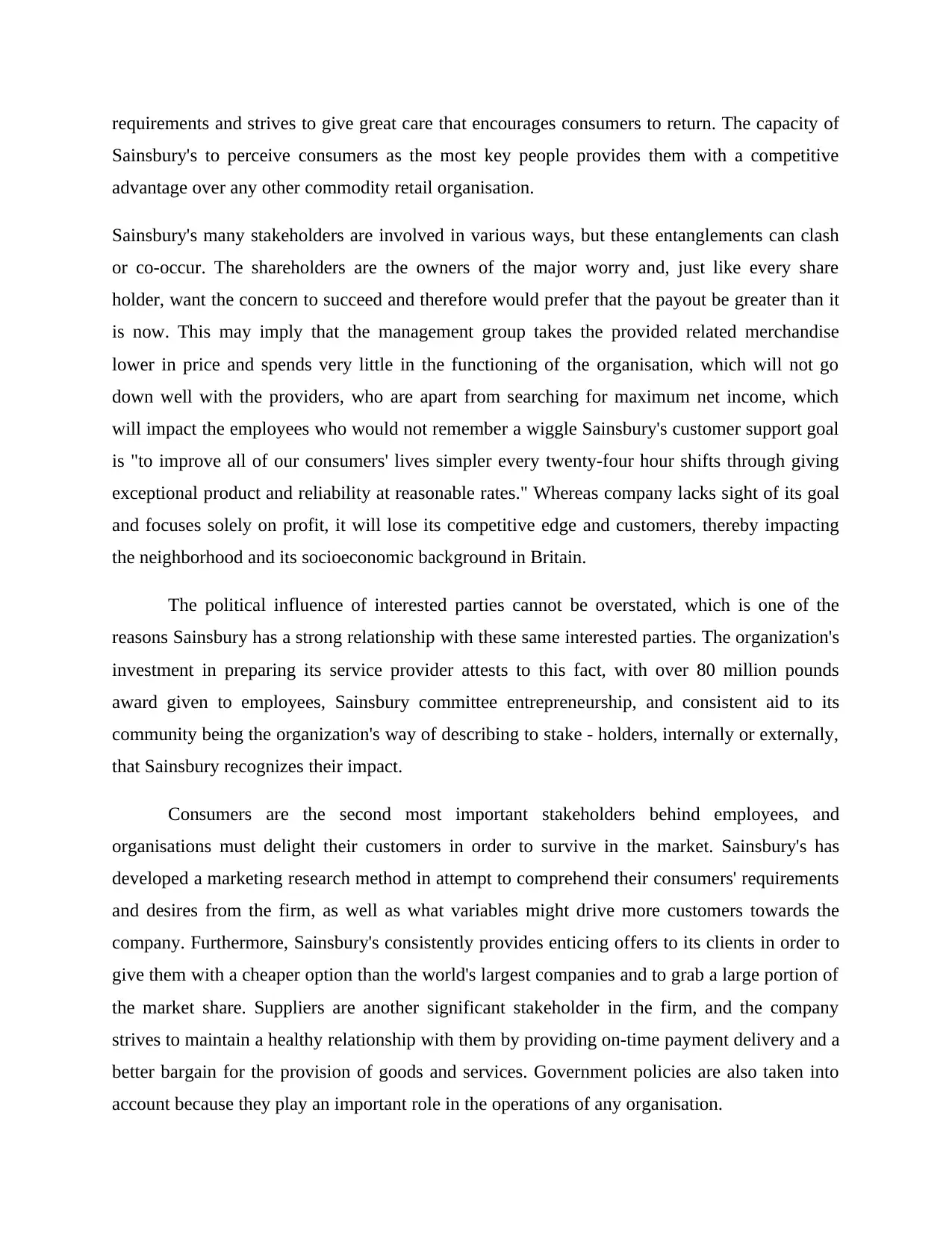
requirements and strives to give great care that encourages consumers to return. The capacity of
Sainsbury's to perceive consumers as the most key people provides them with a competitive
advantage over any other commodity retail organisation.
Sainsbury's many stakeholders are involved in various ways, but these entanglements can clash
or co-occur. The shareholders are the owners of the major worry and, just like every share
holder, want the concern to succeed and therefore would prefer that the payout be greater than it
is now. This may imply that the management group takes the provided related merchandise
lower in price and spends very little in the functioning of the organisation, which will not go
down well with the providers, who are apart from searching for maximum net income, which
will impact the employees who would not remember a wiggle Sainsbury's customer support goal
is "to improve all of our consumers' lives simpler every twenty-four hour shifts through giving
exceptional product and reliability at reasonable rates." Whereas company lacks sight of its goal
and focuses solely on profit, it will lose its competitive edge and customers, thereby impacting
the neighborhood and its socioeconomic background in Britain.
The political influence of interested parties cannot be overstated, which is one of the
reasons Sainsbury has a strong relationship with these same interested parties. The organization's
investment in preparing its service provider attests to this fact, with over 80 million pounds
award given to employees, Sainsbury committee entrepreneurship, and consistent aid to its
community being the organization's way of describing to stake - holders, internally or externally,
that Sainsbury recognizes their impact.
Consumers are the second most important stakeholders behind employees, and
organisations must delight their customers in order to survive in the market. Sainsbury's has
developed a marketing research method in attempt to comprehend their consumers' requirements
and desires from the firm, as well as what variables might drive more customers towards the
company. Furthermore, Sainsbury's consistently provides enticing offers to its clients in order to
give them with a cheaper option than the world's largest companies and to grab a large portion of
the market share. Suppliers are another significant stakeholder in the firm, and the company
strives to maintain a healthy relationship with them by providing on-time payment delivery and a
better bargain for the provision of goods and services. Government policies are also taken into
account because they play an important role in the operations of any organisation.
Sainsbury's to perceive consumers as the most key people provides them with a competitive
advantage over any other commodity retail organisation.
Sainsbury's many stakeholders are involved in various ways, but these entanglements can clash
or co-occur. The shareholders are the owners of the major worry and, just like every share
holder, want the concern to succeed and therefore would prefer that the payout be greater than it
is now. This may imply that the management group takes the provided related merchandise
lower in price and spends very little in the functioning of the organisation, which will not go
down well with the providers, who are apart from searching for maximum net income, which
will impact the employees who would not remember a wiggle Sainsbury's customer support goal
is "to improve all of our consumers' lives simpler every twenty-four hour shifts through giving
exceptional product and reliability at reasonable rates." Whereas company lacks sight of its goal
and focuses solely on profit, it will lose its competitive edge and customers, thereby impacting
the neighborhood and its socioeconomic background in Britain.
The political influence of interested parties cannot be overstated, which is one of the
reasons Sainsbury has a strong relationship with these same interested parties. The organization's
investment in preparing its service provider attests to this fact, with over 80 million pounds
award given to employees, Sainsbury committee entrepreneurship, and consistent aid to its
community being the organization's way of describing to stake - holders, internally or externally,
that Sainsbury recognizes their impact.
Consumers are the second most important stakeholders behind employees, and
organisations must delight their customers in order to survive in the market. Sainsbury's has
developed a marketing research method in attempt to comprehend their consumers' requirements
and desires from the firm, as well as what variables might drive more customers towards the
company. Furthermore, Sainsbury's consistently provides enticing offers to its clients in order to
give them with a cheaper option than the world's largest companies and to grab a large portion of
the market share. Suppliers are another significant stakeholder in the firm, and the company
strives to maintain a healthy relationship with them by providing on-time payment delivery and a
better bargain for the provision of goods and services. Government policies are also taken into
account because they play an important role in the operations of any organisation.
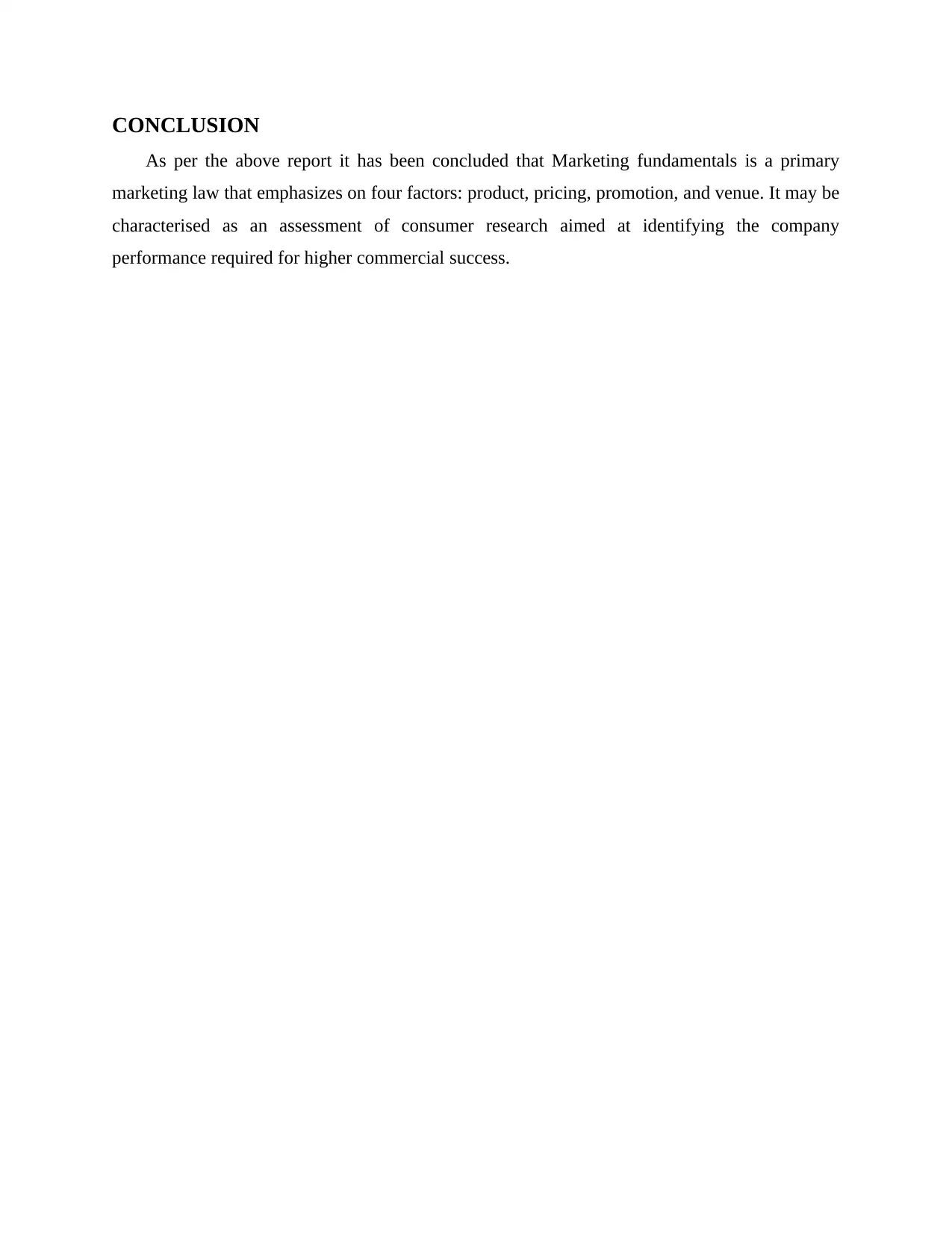
CONCLUSION
As per the above report it has been concluded that Marketing fundamentals is a primary
marketing law that emphasizes on four factors: product, pricing, promotion, and venue. It may be
characterised as an assessment of consumer research aimed at identifying the company
performance required for higher commercial success.
As per the above report it has been concluded that Marketing fundamentals is a primary
marketing law that emphasizes on four factors: product, pricing, promotion, and venue. It may be
characterised as an assessment of consumer research aimed at identifying the company
performance required for higher commercial success.
Paraphrase This Document
Need a fresh take? Get an instant paraphrase of this document with our AI Paraphraser
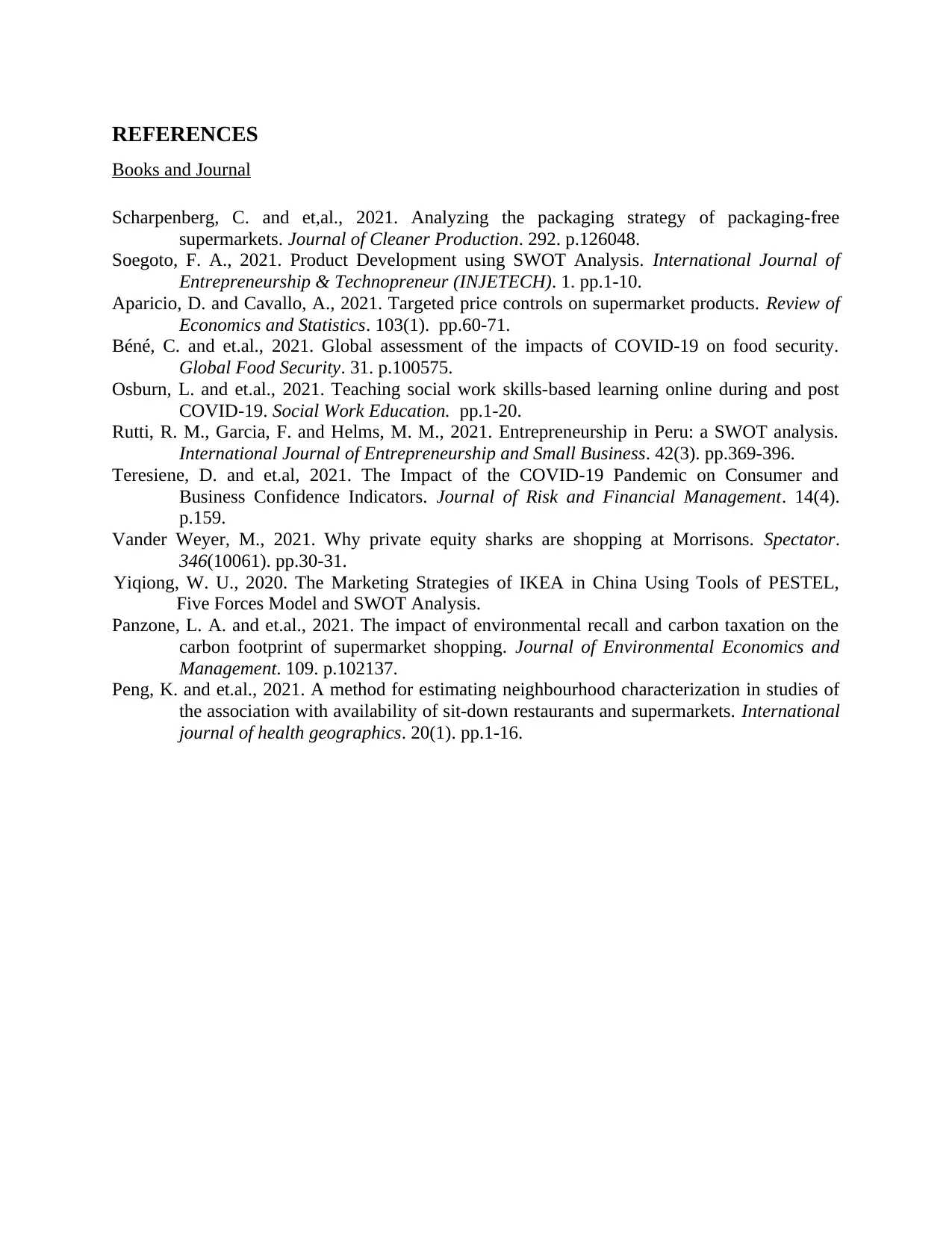
REFERENCES
Books and Journal
Scharpenberg, C. and et,al., 2021. Analyzing the packaging strategy of packaging-free
supermarkets. Journal of Cleaner Production. 292. p.126048.
Soegoto, F. A., 2021. Product Development using SWOT Analysis. International Journal of
Entrepreneurship & Technopreneur (INJETECH). 1. pp.1-10.
Aparicio, D. and Cavallo, A., 2021. Targeted price controls on supermarket products. Review of
Economics and Statistics. 103(1). pp.60-71.
Béné, C. and et.al., 2021. Global assessment of the impacts of COVID-19 on food security.
Global Food Security. 31. p.100575.
Osburn, L. and et.al., 2021. Teaching social work skills-based learning online during and post
COVID-19. Social Work Education. pp.1-20.
Rutti, R. M., Garcia, F. and Helms, M. M., 2021. Entrepreneurship in Peru: a SWOT analysis.
International Journal of Entrepreneurship and Small Business. 42(3). pp.369-396.
Teresiene, D. and et.al, 2021. The Impact of the COVID-19 Pandemic on Consumer and
Business Confidence Indicators. Journal of Risk and Financial Management. 14(4).
p.159.
Vander Weyer, M., 2021. Why private equity sharks are shopping at Morrisons. Spectator.
346(10061). pp.30-31.
Yiqiong, W. U., 2020. The Marketing Strategies of IKEA in China Using Tools of PESTEL,
Five Forces Model and SWOT Analysis.
Panzone, L. A. and et.al., 2021. The impact of environmental recall and carbon taxation on the
carbon footprint of supermarket shopping. Journal of Environmental Economics and
Management. 109. p.102137.
Peng, K. and et.al., 2021. A method for estimating neighbourhood characterization in studies of
the association with availability of sit-down restaurants and supermarkets. International
journal of health geographics. 20(1). pp.1-16.
Books and Journal
Scharpenberg, C. and et,al., 2021. Analyzing the packaging strategy of packaging-free
supermarkets. Journal of Cleaner Production. 292. p.126048.
Soegoto, F. A., 2021. Product Development using SWOT Analysis. International Journal of
Entrepreneurship & Technopreneur (INJETECH). 1. pp.1-10.
Aparicio, D. and Cavallo, A., 2021. Targeted price controls on supermarket products. Review of
Economics and Statistics. 103(1). pp.60-71.
Béné, C. and et.al., 2021. Global assessment of the impacts of COVID-19 on food security.
Global Food Security. 31. p.100575.
Osburn, L. and et.al., 2021. Teaching social work skills-based learning online during and post
COVID-19. Social Work Education. pp.1-20.
Rutti, R. M., Garcia, F. and Helms, M. M., 2021. Entrepreneurship in Peru: a SWOT analysis.
International Journal of Entrepreneurship and Small Business. 42(3). pp.369-396.
Teresiene, D. and et.al, 2021. The Impact of the COVID-19 Pandemic on Consumer and
Business Confidence Indicators. Journal of Risk and Financial Management. 14(4).
p.159.
Vander Weyer, M., 2021. Why private equity sharks are shopping at Morrisons. Spectator.
346(10061). pp.30-31.
Yiqiong, W. U., 2020. The Marketing Strategies of IKEA in China Using Tools of PESTEL,
Five Forces Model and SWOT Analysis.
Panzone, L. A. and et.al., 2021. The impact of environmental recall and carbon taxation on the
carbon footprint of supermarket shopping. Journal of Environmental Economics and
Management. 109. p.102137.
Peng, K. and et.al., 2021. A method for estimating neighbourhood characterization in studies of
the association with availability of sit-down restaurants and supermarkets. International
journal of health geographics. 20(1). pp.1-16.
1 out of 14
Related Documents
Your All-in-One AI-Powered Toolkit for Academic Success.
+13062052269
info@desklib.com
Available 24*7 on WhatsApp / Email
![[object Object]](/_next/static/media/star-bottom.7253800d.svg)
Unlock your academic potential
© 2024 | Zucol Services PVT LTD | All rights reserved.




